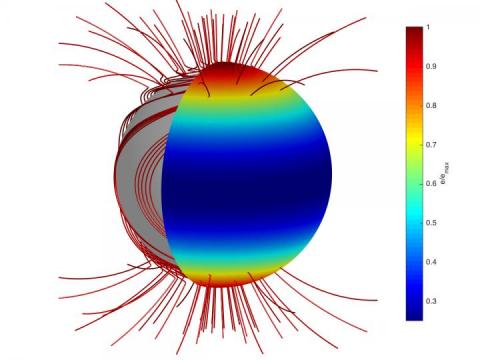When a massive star consumes its nuclear fuel and collapses under its own gravity in a supernova explosion, it can result in a neutron star. These very dense objects have a radius of about 10 kilometers and yet are 1.5 times more massive than the Sun. They have very strong magnetic fields and are rapid rotators, with some neutron stars spinning more than 100 times per second round their axis.
Neutron stars are typically modeled with a magnetic field that has a north and south magnetic pole, like the Earth's. However, a simple 'dipole' model does not explain puzzling aspects of neutron stars, such as why some parts of their surface are much hotter than their average temperature.

Tightly wound-up magnetic field used as initial state in the simulation. Credit: K. Gourgouliatos, R. Hollerbach, U. Durham, U. Leeds
A newborn neutron star does not rotate uniformly - various parts of it spin with different speeds. This winds up and stretches the magnetic field inside the star in a way that resembles a tight ball of yarn. Using computer simulations, the authors believe that a highly wound magnetic field is unstable. It spontaneously generates knots, which emerge from the surface of the neutron star and form spots where the magnetic field is much stronger than the large-scale field. These magnetic spots produce strong electric currents, which eventually release heat, in the same way heat is produced when an electric current flows in a resistor.
The simulations show that it is possible to generate a magnetic spot with a radius of a few kilometers and a magnetic field strength in excess of 10 billion Tesla. The spot can last several million years, even if the total magnetic field of the neutron star has decayed. This could explain the strange behavior of some magnetars, for example the exotic SGR 0418+5729, which has an unusually low spin rate and a relatively weak large-scale magnetic field but erupts sporadically with high-energy radiation.





Comments